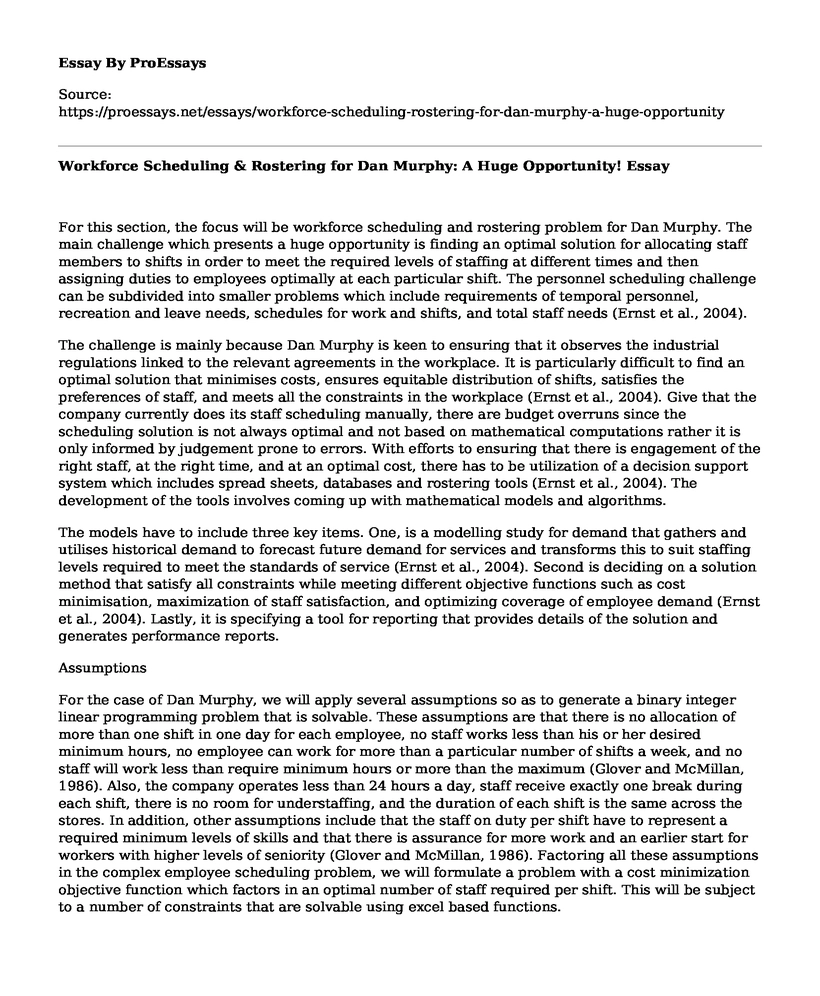For this section, the focus will be workforce scheduling and rostering problem for Dan Murphy. The main challenge which presents a huge opportunity is finding an optimal solution for allocating staff members to shifts in order to meet the required levels of staffing at different times and then assigning duties to employees optimally at each particular shift. The personnel scheduling challenge can be subdivided into smaller problems which include requirements of temporal personnel, recreation and leave needs, schedules for work and shifts, and total staff needs (Ernst et al., 2004).
The challenge is mainly because Dan Murphy is keen to ensuring that it observes the industrial regulations linked to the relevant agreements in the workplace. It is particularly difficult to find an optimal solution that minimises costs, ensures equitable distribution of shifts, satisfies the preferences of staff, and meets all the constraints in the workplace (Ernst et al., 2004). Give that the company currently does its staff scheduling manually, there are budget overruns since the scheduling solution is not always optimal and not based on mathematical computations rather it is only informed by judgement prone to errors. With efforts to ensuring that there is engagement of the right staff, at the right time, and at an optimal cost, there has to be utilization of a decision support system which includes spread sheets, databases and rostering tools (Ernst et al., 2004). The development of the tools involves coming up with mathematical models and algorithms.
The models have to include three key items. One, is a modelling study for demand that gathers and utilises historical demand to forecast future demand for services and transforms this to suit staffing levels required to meet the standards of service (Ernst et al., 2004). Second is deciding on a solution method that satisfy all constraints while meeting different objective functions such as cost minimisation, maximization of staff satisfaction, and optimizing coverage of employee demand (Ernst et al., 2004). Lastly, it is specifying a tool for reporting that provides details of the solution and generates performance reports.
Assumptions
For the case of Dan Murphy, we will apply several assumptions so as to generate a binary integer linear programming problem that is solvable. These assumptions are that there is no allocation of more than one shift in one day for each employee, no staff works less than his or her desired minimum hours, no employee can work for more than a particular number of shifts a week, and no staff will work less than require minimum hours or more than the maximum (Glover and McMillan, 1986). Also, the company operates less than 24 hours a day, staff receive exactly one break during each shift, there is no room for understaffing, and the duration of each shift is the same across the stores. In addition, other assumptions include that the staff on duty per shift have to represent a required minimum levels of skills and that there is assurance for more work and an earlier start for workers with higher levels of seniority (Glover and McMillan, 1986). Factoring all these assumptions in the complex employee scheduling problem, we will formulate a problem with a cost minimization objective function which factors in an optimal number of staff required per shift. This will be subject to a number of constraints that are solvable using excel based functions.
Our choice of the problem is based on curiosity of applying a real life situation to solve a supply chain challenge using the mathematical models we learn in throughout the course. There is also a gap particularly in solving personnel scheduling and rostering problems as previously many scholarly supply chain experts have focused on developing general labour scheduling models that are also not in the area of liquor distribution.
Bibliography
Ernst, A. et al., 2004. Staff scheduling and rostering: A review of applications, methods and models. European Journal of Operational Research, 153(1), pp.3-27.
Glover, F. & Mcmillan, C., 1986. The general employee scheduling problem. An integration of MS and AI. Computers & Operations Research, 13(5), pp.563-573.
Anon, Real Company reviews from real employees. SEEK. Available at: https://www.seek.com.au/companies/dan-murphys-806659 [Accessed May 27, 2019].
Cite this page
Workforce Scheduling & Rostering for Dan Murphy: A Huge Opportunity!. (2023, Jan 14). Retrieved from https://proessays.net/essays/workforce-scheduling-rostering-for-dan-murphy-a-huge-opportunity
If you are the original author of this essay and no longer wish to have it published on the ProEssays website, please click below to request its removal:
- Educational Goal Statement: A Career in Gender Studies and Social Justice
- Logistics, Operations and Supply Chain Management of Honda Motor Company
- Implications of Employee Recruiting to Nursing Leaders Paper Example
- Laws on Food: Food Regulations Essay Example
- Essay Sample on Effective Communication in the Diverse Workplace
- Essay Example on Comparing IFRS & GAAP for Recording AFS Instruments
- Essay Example on Jim's Performance Issues: Manager-Employee Conversation Strategies







